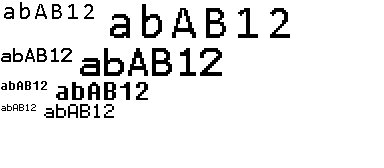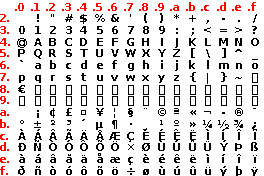Fonts¶
The Basic edition includes the Terminal font with

-
sizes 8, 12, 16 and 24;
-
large sizes 16, 12, 32 and 48;
-
ISO 8859-1 or Latin 1 extended set of characters
0x00..0xff;

Configuration¶
The fonts are provided as header files and added to the application statically at build-time.
No configuration is required, as FONT_MODE is set to USE_FONT_TERMINAL.
Use¶
String text = "abAB12";
myScreen.selectFont(Font_Terminal16x24);
myScreen.gText(0, 0, text);
myScreen.gTextLarge(100, 0, text);
selectFont()- selects the font based on its index, from range
0..fontMax() - 1; or its name,Font_Terminal6x8,Font_Terminal8x12,Font_Terminal12x16andFont_Terminal16x24. gText()- prints a text at the graphic coordinates.
gTextLarge()- prints a text at the graphic coordinates with twice the size.
On the example above, the 16x24 character becomes a 32x48 character.
All other functions described at the example for Text are available.
Example¶
This is the core of the code from example EXT4_LargeFont.ino.
void displayMultiplier()
{
myScreen.setOrientation(ORIENTATION_LANDSCAPE);
uint16_t x = 0;
uint16_t y = 0;
String text = "abAB12";
uint8_t length = text.length();
myScreen.selectFont(Font_Terminal16x24);
myScreen.gText(x, y, text);
x += myScreen.characterSizeX() * length;
myScreen.gTextLarge(x, y, text);
y += myScreen.characterSizeY() * 2;
x = 0;
myScreen.selectFont(Font_Terminal12x16);
myScreen.gText(x, y, text);
x += myScreen.characterSizeX() * length;
myScreen.gTextLarge(x, y, text);
y += myScreen.characterSizeY() * 2;
x = 0;
myScreen.selectFont(Font_Terminal8x12);
myScreen.gText(x, y, text);
x += myScreen.characterSizeX() * length;
myScreen.gTextLarge(x, y, text);
y += myScreen.characterSizeY() * 2;
x = 0;
myScreen.selectFont(Font_Terminal6x8);
myScreen.gText(x, y, text);
x += myScreen.characterSizeX() * length;
myScreen.gTextLarge(x, y, text);
y += myScreen.characterSizeY() * 2;
x = 0;
myScreen.flush();
hV_HAL_delayMilliseconds(8000);
}